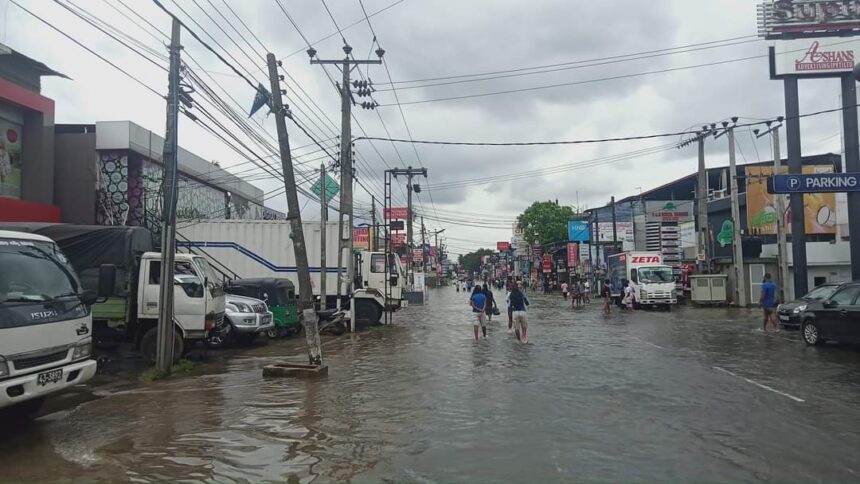Natural disasters affect economies across the globe, but their impact is most profound in developing and less developed countries like Sri Lanka. The country’s heavy rains, particularly in recent months, have brought flooding and landslides that not only cause loss of life and damage infrastructure but also strain the economy. From macroeconomic to microeconomic levels, the repercussions are deeply felt, exposing the vulnerabilities of an economy trying to balance growth and sustainability.
Macroeconomic Impact
Heavy rains impose a significant macroeconomic burden on the nation. The immediate damage to infrastructure such as roads, bridges, and power lines interrupts economic activity across sectors. For example, transportation networks are disrupted, preventing the smooth flow of goods and services. In a country like Sri Lanka, where key industries like agriculture and manufacturing rely heavily on efficient logistics, these disruptions lead to significant delays and increased costs.
Additionally, heavy rainfall increases the government’s health expenditure. Floods and stagnant water give rise to diseases like dengue and waterborne illnesses, overwhelming the healthcare system. Resources that could have been allocated to developmental projects or long-term healthcare improvements must instead be redirected to emergency response and disease control. This diversion of funds slows the country’s overall development trajectory, forcing the government to adopt short-term solutions instead of focusing on critical long-term investments in sectors like education and infrastructure.
The impact of natural disasters on agriculture, a cornerstone of Sri Lanka’s economy, cannot be understated. Heavy rains result in the loss of crops and the destruction of arable land due to flooding and soil erosion. This not only diminishes food production but also impacts exports, driving up food prices domestically and reducing income from agricultural exports abroad. Sri Lanka, already grappling with inflationary pressures, is pushed further toward economic instability by such shocks.
Microeconomic Impact
At the microeconomic level, the consequences of heavy rains are even more direct and personal, affecting households, firms, and local governments. Flooding often leads to the destruction of homes and properties, displacing families and erasing the hard-earned wealth of individuals. The cost of repairs or relocation puts a strain on household finances, increasing poverty levels and reducing consumer spending, which is crucial for the overall economy.
Firms, particularly small and medium enterprises (SMEs), suffer from the loss of inventory, equipment, and operational downtime. SMEs are less likely to have the resources to recover quickly from such setbacks, and many are forced to close down. The knock-on effect is reduced employment, decreased income for workers, and a rise in unemployment rates. As these businesses struggle, the government loses tax revenue, which could have been used to fund public services and infrastructure projects.
Governments at both local and national levels face additional fiscal pressures due to the rising costs of disaster relief and reconstruction efforts. With limited budgets and external debt already burdening Sri Lanka, disaster recovery becomes an expensive proposition. Resources that would otherwise be allocated toward long-term capital projects, such as building roads, schools, and hospitals, are channeled into immediate disaster response, further delaying progress in physical and human capital formation.
The Long Road to Recovery
The cumulative effects of these macroeconomic and microeconomic impacts mean that Sri Lanka, like many developing countries, faces long-term consequences from natural disasters. Heavy rains undermine economic growth by disrupting key sectors, increasing public and private expenditure on health and recovery, and limiting investments in critical areas. The cycle of destruction and recovery becomes difficult to break, especially in a country already grappling with economic challenges.
Building resilience to such disasters is critical. While developed countries may have the resources to mitigate and recover quickly from natural disasters, developing nations like Sri Lanka often lack these capacities. Investment in disaster-resilient infrastructure, improved disaster preparedness, and sustainable agricultural practices are vital steps toward breaking the cycle of economic vulnerability that these rains exacerbate.
Heavy rains and their aftermath expose the fragility of Sri Lanka’s economy, highlighting the urgent need for both immediate and long-term solutions. The economic cost of these natural disasters, from healthcare to productivity losses, continues to weigh down progress, demanding a strategic approach to building a more resilient economy.





